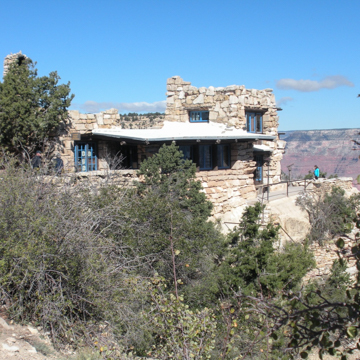You are here
Lookout Studio
The Lookout epitomizes the melding of nature, commercialism, and romanticism typical of the collaborations between the Atchison, Topeka and Santa Fe Railway and the Fred Harvey Company at the Grand Canyon. In 1914, the Fred Harvey Company began a major expansion of its Grand Canyon facilities, and one of the first buildings completed that year was the Lookout (now known as the Lookout Studio). A short walk from the El Tovar Hotel, the building was precariously perched (or so it seemed) at the canyon’s edge to give visitors the opportunity to take photographs and use telescopes provided by the company, in addition to purchasing souvenirs and gifts.
Designed by Mary Colter, the Lookout was built of native stone in coursed rubble masonry. The building’s uneven parapet reflects the colors and forms of the surrounding cliffs. Less archaeologically accurate than Colter’s 1905 Hopi House, the design of the Lookout was primarily influenced by the surrounding landscape, mostly the natural rock outcroppings of the canyon’s edge. The structure seemed to be an extension of the rim itself, emerging from the bedrock. The roof was planted with small native shrubs to reinforce the naturalistic appearance.
Generally rectangular in plan, the small, multi-level structure contains an observation room with a small balcony enclosed by a patterned railing. Posts, beams, and ceiling joists are peeled logs, which (along with the stone walls) are exposed on the interior; the floor is scored concrete. A small stone fireplace provides a homey ambiance. Because there are so many viewing windows in the perimeter walls, the building’s interior is, overall, lighter and airier than most other Colter designs. The building has been altered relatively little over the years and still serves a daily stream of visitors to the Grand Canyon.
Writing Credits
If SAH Archipedia has been useful to you, please consider supporting it.
SAH Archipedia tells the story of the United States through its buildings, landscapes, and cities. This freely available resource empowers the public with authoritative knowledge that deepens their understanding and appreciation of the built environment. But the Society of Architectural Historians, which created SAH Archipedia with University of Virginia Press, needs your support to maintain the high-caliber research, writing, photography, cartography, editing, design, and programming that make SAH Archipedia a trusted online resource available to all who value the history of place, heritage tourism, and learning.














